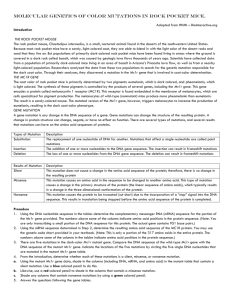
What specific trait did researchers study in this investigation? Fur color, specifically melanism, is the trait they studied.ī. Watch the short film titled The Making of the Fittest: Natural Selection and Adaptation. Smithsonian, February 10, 2009).Īllele and Phenotype Frequencies in Rock Pocket Mouse Populations Published August 2012 Updated August 2015Ģ. These discoveries reveal that the evolution of melanism is not some incredibly rare accident,īut a common, repeatable process. In some species, precisely the same mutations have occurred independently in the origin of theirĭark forms. Kinds of lizards, and of domestic cows, sheep, and chickens are caused by mutations in this very same That is not a very interesting nugget of information, until I tell you that the melanicįorms of jaguars, snow geese, arctic fox, fairy wrens, banaquits, golden lion tamarins, arctic skua, two The gene involved in the origin of melanism in rock pocket mice is called melanocortin receptorġ, or MC 1 R for short. Surroundings have a survival advantage over mismatched mice in each of the two habitats. To be an adaptation against predators, particularly owls. This color-matching between fur color and habitat background appears

Naturalists in the 1930s observed that miceįound on the lava rocks were typically melanic, while those on the surrounding sand-colored granite Mouse, which occurs in dark black and a light, sandy color. Were produced by lava flows over the past two million years. In the deserts of the southwestern United States, for instance, there are outcrops of very dark rocks that black pigment does conceal some animals from predators. Melanin protects us and otherĪnimals from the ultraviolet rays of the sun it can help animals in colder climates or higher altitudes Melanic pigmentation can serve many roles. All sorts of moths, beetles, butterflies, snakes, lizards and birds have forms thatĪll of these so-called “melanic” forms result from increased production of the pigment melanin in the “One of the most widespread phenomena in the animal kingdom is the occurrence of darkly pigmented Leading evolutionary biologist and Howard Hughes Medical Institute investigator: Read the following excerpt from an article published in Smithsonian magazine by Dr.
Rock pocket mouse worksheet answer key code#
Genetic code chart (see page 4 or any biology textbook)ġ. Their analyses led to theirĭiscovery of a mutation in the Mc1r gene, which is involved in coat-color determination. Populations in search of the genetic mutation responsible for the dark color.

Researchers analyzed the data from these two Lava flow, as well as from a nearby light-colored population. Scientists have collected dataįrom a population of primarily dark-colored mice living in an area of basalt in Arizona called the Pinacate The basalt formed from cooling lava flows thousands of years ago. However, populations of primarilyĭark-colored rock pocket mice have been found living in areas where a dark rock called basalt covers the In with the light-colored desert rocks and sand on which they live. Most of these mice have a sandy, light-colored coat that enables them to blend

The rock pocket mouse, Chaetodipus intermedius, a small, nocturnal animal, is found in the deserts of the ANSWER KEY PARTA:NATURAL SELECTION AND EVOLUTION OF ROCK POCKET MOUSE POPULATIONS INTRODUCTION


 0 kommentar(er)
0 kommentar(er)
